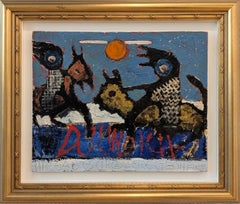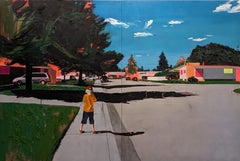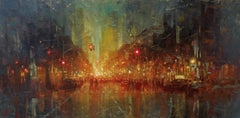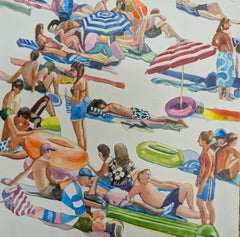Addition.Agency Figurative Paintings
to
2
1
1
Overall Width
to
Overall Height
to
1
1
1
1
1
2
1
1
1
1
1
1
1
2
1
1
1
1
1
1
1
You and I Duel
By Herbert Siebner
Located in Vancouver, CA
Herbert Siebner (1925-2004) was a German-born Canadian painter whose work is characterized by its expressive use of color and texture, and its exploration of themes of war, exile, an...
Category
1980s Expressionist Figurative Paintings
Materials
Masonite, Acrylic
$12,800 Sale Price
20% Off
3rd Avenue
By Kim Dorland
Located in Vancouver, CA
Kim Dorland is a contemporary Canadian artist known for his expressive landscape paintings that blend abstraction and realism. Born in 1974 in Wainwright, Alberta, Dorland earned his...
Category
2010s Abstract Impressionist Figurative Paintings
Materials
Canvas, Oil, Wood Panel
$60,000 Sale Price
20% Off
Related Items
"NYC - Central Park West" (2019) by Christopher Clark, Cityscape Oil Painting
By Christopher Clark
Located in Denver, CO
"NYC - Central Park West" by Christopher Clark is an original abstract impressionist oil painting on cradled board that is ready to hang.
Christopher has been an artist since earl...
Category
21st Century and Contemporary Abstract Impressionist Figurative Paintings
Materials
Wood Panel, Oil
Christopher Clark"NYC - Central Park West" (2019) by Christopher Clark, Cityscape Oil Painting, 2019
$2,400
H 20 in W 40 in D 1 in
Neon Beach - original figurative painting - contemporary watercolour artwork
By Annabelle Shelton
Located in London, Chelsea
This exceptional artwork is currently on display and available for sale at Signet Contemporary Art Gallery and online.
Neon Beach crackles with colour and movement—a joyful scene th...
Category
21st Century and Contemporary Abstract Impressionist Figurative Paintings
Materials
Watercolor, Wood Panel
$1,648
H 11.82 in W 11.82 in D 1.19 in
Textured abstract figurative original mixed media, vibrant teal/white/brown)
By Svetlana Shalygina
Located in Maricopa, AZ
Svetlana Shalygina's signature figurative abstract, vibrant textured brown & teal create a bold original work of art. There is a unique range of expressionistic strokes, textures and...
Category
2010s Abstract Impressionist Abstract Paintings
Materials
Oil, Pen, Canvas, Mixed Media
Svetlana ShalyginaTextured abstract figurative original mixed media, vibrant teal/white/brown), 2021
$3,450 Sale Price
25% Off
H 36 in W 12 in
"Interior Scene with Figure" Expressionistic Style Oil Painting on Masonite
By Michael Baxte
Located in New York, NY
A strong modernist oil painting depicted in 1969 by Russian painter Michael Baxte. Mostly known for his abstracted figures on canvas or street scenes, this piece is a wonderful representation of his bold still life paintings, with expressive use of color, shape, and form. Later in his career, Baxte explores Expressionism, infusing both European and North American stylistic trends. This piece is from later in his career, but we can feel this underlying style throughout.
Art measures 21.75 x 18 inches
Michael Posner Baxte was born in 1890 in the small town of Staroselje Belarus, Russia. For the first half of the 19th century it was a center of the Chabad movement of Hasidic Jews, but this group was gone by the middle of the 19th century. By the time the Baxte family immigrated to the United States at the beginning of the 20th century, the Jewish population numbered only on the hundreds. The native language of the Baxte family was Yiddish. It is likely that the death of Michael Baxte’s father triggered the family’s immigration. Three older brothers arrived in New York between 1903 and 1905. Michael and his mother, Rebecca, arrived in 1907. By 1910 Michael, his mother, and brother, Joseph, were living in New Orleans and may have spent some time on a Louisiana plantation. Around 1912, Michael Baxte returned to Europe to study the violin. In 1914 he, his mother, and Joseph moved to New York City.
Meanwhile, in Algeria, a talented young woman painter, Violette Mege, was making history. Since for the first time, a woman won the prestigious Beaux Art competition in Algeria. At first, the awards committee denied her the prize but, with French government intervention, Mege eventually prevailed. She won again 3 years later and, in 1916, used the scholarship to visit the United States of America. When Violette came to New York, she met Baxte, who was, by then, an accomplished violinist, teacher, and composer. Baxte’s compositions were performed at the Tokyo Imperial Theater, and in 1922 he was listed in the American Jewish Yearbook as one of the prominent members of the American Jewish community. As a music teacher he encouraged individual expression. Baxte stated, “No pupil should ever be forced into imitation of the teacher. Art is a personal experience, and the teacher’s truest aim must be to awaken this light of personality through the patient light of science.”
By 1920 Michael Baxte and Violette Mege were living together in Manhattan. Although they claimed to be living as husband and wife, it seems that their marriage did not become official until 1928. On their “unofficial” honeymoon around 1917, in Algiers, Baxte confided to her his ambition to paint. There and later in New Mexico where the wonderful steeped sunlight approximates the coloring of Algiers, she taught him his heart’s desire. He never had any other teacher. She never had any other pupil. For ten years she devoted all her time, energy, and ambition to teaching, encouraging, inspiring him. Then in 1928, their mutual strivings were rewarded, as his works were being chosen as one of the two winners in the Dudensing National Competition for American Painters. Out of 150 artists from across the country participated in the Dudensing, and Michael Posner Baxte and, Robert Fawcett...
Category
1960s Expressionist Interior Paintings
Materials
Oil, Masonite
$1,600 Sale Price
20% Off
H 21.75 in W 18 in D 0.25 in
Modern Abstract Female Nude Oil on Canvas Gestural Figurative Multi-color
By Jessica Benjamin
Located in ALCOY/ALCOI, ES
EVE
Description: Oil on canvas, figurative, nude, multi-color, gestural, modern, abstract
This painting features Eve, the mother of women, sitting in contemplation in the garden of Eden. Through the use of expressive brushwork, and color, this painting tells a new version of this story from antiquity.
Jessica Benjamin was born in Bloomington, IL and graduated from the New York Academy of Art with his MFA in 2014.
Her paintings have been featured on the cover and interiors of three albums by Wynton...
Category
2010s Abstract Impressionist Figurative Paintings
Materials
Canvas, Oil
$3,150
H 14 in W 12 in D 2 in
"Landscape Scene of Mexican Villagers" Expressionistic Oil Painting on Masonite
By Michael Baxte
Located in New York, NY
A strong modernist oil painting depicted in 1971 by Russian painter Michael Baxte. Mostly known for his abstracted figures on canvas or street scenes, this piece is a wonderful representation of his landscape paintings, with expressive use of color, shape, and form. Later in his career, Baxte explores Expressionism, infusing both European and North American stylistic trends. This piece is from later in his career, but we can feel this underlying style throughout.
Art measures 18 x 21.75 inches
Michael Posner Baxte was born in 1890 in the small town of Staroselje Belarus, Russia. For the first half of the 19th century it was a center of the Chabad movement of Hasidic Jews, but this group was gone by the middle of the 19th century. By the time the Baxte family immigrated to the United States at the beginning of the 20th century, the Jewish population numbered only on the hundreds. The native language of the Baxte family was Yiddish. It is likely that the death of Michael Baxte’s father triggered the family’s immigration. Three older brothers arrived in New York between 1903 and 1905. Michael and his mother, Rebecca, arrived in 1907. By 1910 Michael, his mother, and brother, Joseph, were living in New Orleans and may have spent some time on a Louisiana plantation. Around 1912, Michael Baxte returned to Europe to study the violin. In 1914 he, his mother, and Joseph moved to New York City.
Meanwhile, in Algeria, a talented young woman painter, Violette Mege, was making history. Since for the first time, a woman won the prestigious Beaux Art competition in Algeria. At first, the awards committee denied her the prize but, with French government intervention, Mege eventually prevailed. She won again 3 years later and, in 1916, used the scholarship to visit the United States of America. When Violette came to New York, she met Baxte, who was, by then, an accomplished violinist, teacher, and composer. Baxte’s compositions were performed at the Tokyo Imperial Theater, and in 1922 he was listed in the American Jewish Yearbook as one of the prominent members of the American Jewish community. As a music teacher he encouraged individual expression. Baxte stated, “No pupil should ever be forced into imitation of the teacher. Art is a personal experience, and the teacher’s truest aim must be to awaken this light of personality through the patient light of science.”
By 1920 Michael Baxte and Violette Mege were living together in Manhattan. Although they claimed to be living as husband and wife, it seems that their marriage did not become official until 1928. On their “unofficial” honeymoon around 1917, in Algiers, Baxte confided to her his ambition to paint. There and later in New Mexico where the wonderful steeped sunlight approximates the coloring of Algiers, she taught him his heart’s desire. He never had any other teacher. She never had any other pupil. For ten years she devoted all her time, energy, and ambition to teaching, encouraging, inspiring him. Then in 1928, their mutual strivings were rewarded, as his works were being chosen as one of the two winners in the Dudensing National Competition for American Painters. Out of 150 artists from across the country participated in the Dudensing, and Michael Posner Baxte and, Robert Fawcett, were the winners.
In his 1924 naturalization application, he indicated that he was sometimes known as “Michael Posner Baxte.” One of the witnesses to his application was Bernard Karfiol, a Jewish American artist. That’s when Michael may...
Category
1960s Expressionist Landscape Paintings
Materials
Oil, Masonite
$2,000
H 18 in W 21.75 in D 0.25 in
Inflatable Boat Beach -original figurative painting-contemporary watercolour art
By Annabelle Shelton
Located in London, Chelsea
This exceptional artwork is currently on display and available for sale at Signet Contemporary Art Gallery and online.
In Inflatable Boat Beach, Annabelle Shelton paints a playful a...
Category
21st Century and Contemporary Abstract Impressionist Figurative Paintings
Materials
Watercolor, Wood Panel
$1,373
H 11.82 in W 11.82 in D 1.19 in
Benavente Solis 25 Campo de Mallorca original expressionist acrylic painting
By Benavente Solis
Located in CORAL GABLES - MIAMI, FL
original expressionist acrylic painting. Framed
During its first exhibition in Paris, the French press catalogs it like "The Catalan Sorolla".
Honorary Member of the MECOART (Medit...
Category
1990s Expressionist Figurative Paintings
Materials
Wood, Acrylic
$3,200
H 21.26 in W 25.6 in D 0.4 in
Marian Begg, Expressionist Portrait by Joseph Solman
By Joseph Solman
Located in Long Island City, NY
In the mid-1960s Joseph Solman (American, 1909 - 2008) was commissioned to create portraits of the Begg family. This is a portrait of Marian Begg, the mother in the mid-century nuclear family...
Category
1960s Expressionist Portrait Paintings
Materials
Oil, Masonite
$9,000
H 27.5 in W 19 in
In Venice
By Charles Webster Hawthorne
Located in Bryn Mawr, PA
Like his mentor the great American Impressionist William Merritt Chase, Charles Webster Hawthorne was equally admired in his own day as both a talented painter and a highly influential instructor. Hawthorne first studied with Chase at his Shinnecock Summer School of Art, which was specifically dedicated to open-air landscape painting. Not only did Hawthorne quickly absorb all the principles of Chase’s instruction, but he also became determined to found his own school based on the same model. In 1899 Hawthorne discovered the small fishing village of Provincetown on the furthermost tip of Cape Cod, and after purchasing a large house on Miller Hill, he opened the Cape Cod School of Art, which proved to be an immediate success.
While Hawthorne’s own approach as a teacher owed much to Chase, he developed a distinctly unique painting style and teaching method that defies easy categorization. He was greatly impressed with the work of Franz Hals, which he was exposed to during his trip to Holland in the summer of 1898. Hawthorne was particularly struck by Hals’ Regentesses of the Old Men’s Almhouse, and from this work he absorbed a deep appreciation for the power of human expression and an economy of technique. Hawthorne applied these lessons to his own realistic portraits of Provincetown fishermen and their families; these works have a somber, almost melancholy quality to them, and they reveal a sense of the vulnerability of the human condition.
Stylistically, Hawthorne maintained a life-long commitment to the importance of color. “Beauty in art,” he said, “is the delicious notes of color one against the other.” Of equal importance to him was capturing the effects of light. He told his students: “Everything in painting is a matter of silhouettes. Hold light against shadow, not light against light.” He developed a particular technique of layering glazes and texturing the surface of his paintings, which heightens the relationship between the colors and creates a light effect that seems to emanate from within the painting. These stylistic techniques in combination with his straightforward compositions of one or more figures shown at close range create the hallmarks of Hawthorne’s best paintings.
Hawthorne and his wife Ethel’s 1905-1907 trip to Italy did not result in a drastic impact on his artistic style. Nonetheless, it proved to be a transformative and enlightening voyage. The extensive trip was financed by collectors who paid in advance for a painting to be produced abroad. On the trip, Hawthorne explored the work of old masters and was struck particularly by the paintings of Titian, which to Hawthorne, demonstrated the master’s true adoration for the act of painting itself through his handling of paint and color. Where Titian’s paintings...
Category
Early 1900s Abstract Impressionist Figurative Paintings
Materials
Oil, Panel
Bliss Beach - original figurative painting - contemporary watercolour artwork
By Annabelle Shelton
Located in London, Chelsea
This exceptional artwork is currently on display and available for sale at Signet Contemporary Art Gallery and online.
In Bliss Beach, Annabelle Shelton captures the unmistakable rh...
Category
21st Century and Contemporary Abstract Impressionist Figurative Paintings
Materials
Watercolor, Wood Panel
Annabelle SheltonBliss Beach - original figurative painting - contemporary watercolour artwork, 2025
$1,648
H 11.82 in W 11.82 in D 1.19 in
"Mexican Interior Scene Scene with Figures and Fish" Expressionistic Style
By Michael Baxte
Located in New York, NY
A strong modernist oil painting depicted in the Mid Century by Russian painter Michael Baxte. Mostly known for his abstracted figures on canvas or street scenes, this piece is a wond...
Category
1950s Expressionist Portrait Paintings
Materials
Oil, Masonite
$1,800
H 25.5 in W 21.25 in D 0.25 in



